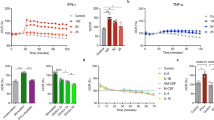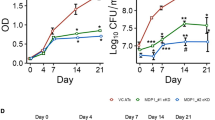Abstract
Detection of cyclic-di-adenosine monophosphate (c-di-AMP), a bacterial second messenger, by the host cytoplasmic surveillance pathway (CSP) is known to elicit type I interferon (IFN) responses, which are crucial to antimicrobial defense1,2,3. However, the mechanisms and role of c-di-AMP signaling in Mycobacterium tuberculosis virulence remain unclear. Here we show that resistance to tuberculosis requires CSP-mediated detection of c-di-AMP produced by M. tuberculosis and that levels of c-di-AMP modulate the fate of infection. We found that a di-adenylate cyclase (disA or dacA)4-overexpressing M. tuberculosis strain that secretes excess c-di-AMP activates the interferon regulatory factor (IRF) pathway with enhanced levels of IFN-β, elicits increased macrophage autophagy, and exhibits substantial virulence attenuation in mice. We show that c-di-AMP-mediated IFN-β induction during M. tuberculosis infection requires stimulator of interferon genes (STING)5-signaling. We observed that c-di-AMP induction of IFN-β is independent of the cytosolic nucleic acid receptor cyclic GMP-AMP (cGAMP) synthase (cGAS)6,7, but cGAS nevertheless contributes substantially to the overall IFN-β response to M. tuberculosis infection. In sum, our results reveal c-di-AMP to be a key mycobacterial pathogen-associated molecular pattern (PAMP) driving host type I IFN responses and autophagy. These findings suggest that modulating the levels of this small molecule may lead to novel immunotherapeutic strategies against tuberculosis.
This is a preview of subscription content, access via your institution
Access options
Subscribe to this journal
Receive 12 print issues and online access
$209.00 per year
only $17.42 per issue
Buy this article
- Purchase on Springer Link
- Instant access to full article PDF
Prices may be subject to local taxes which are calculated during checkout




Similar content being viewed by others
References
Corrigan, R.M. & Grundling, A. Cyclic di-AMP: another second messenger enters the fray. Nat. Rev. Microbiol. 11, 513–524 (2013).
Woodward, J.J., Iavarone, A.T. & Portnoy, D.A. c-di-AMP secreted by intracellular Listeria monocytogenes activates a host type I interferon response. Science 328, 1703–1705 (2010).
Römling, U. Great times for small molecules: c-di-AMP, a second messenger candidate in bacteria and archaea. Sci. Signal. 1, pe39 (2008).
Bai, Y. et al. Mycobacterium tuberculosis Rv3586 (DacA) is a diadenylate cyclase that converts ATP or ADP into c-di-AMP. PLoS ONE 7, e35206 (2012).
Burdette, D.L. et al. STING is a direct innate immune sensor of cyclic di-GMP. Nature 478, 515–518 (2011).
Sun, L., Wu, J., Du, F., Chen, X. & Chen, Z.J. Cyclic GMP-AMP synthase is a cytosolic DNA sensor that activates the type I interferon pathway. Science 339, 786–791 (2013).
Gao, D. et al. Cyclic GMP-AMP synthase is an innate immune sensor of HIV and other retroviruses. Science 341, 903–906 (2013).
Takeuchi, O. & Akira, S. Pattern recognition receptors and inflammation. Cell 140, 805–820 (2010).
McWhirter, S.M. et al. A host type I interferon response is induced by cytosolic sensing of the bacterial second messenger cyclic-di-GMP. J. Exp. Med. 206, 1899–1911 (2009).
Parvatiyar, K. et al. The helicase DDX41 recognizes the bacterial secondary messengers cyclic di-GMP and cyclic di-AMP to activate a type I interferon immune response. Nat. Immunol. 13, 1155–1161 (2012).
Cai, X., Chiu, Y.H. & Chen, Z.J. The cGAS-cGAMP-STING pathway of cytosolic DNA sensing and signaling. Mol. Cell 54, 289–296 (2014).
Paludan, S.R. & Bowie, A.G. Immune sensing of DNA. Immunity 38, 870–880 (2013).
Nelson, J.W. et al. Riboswitches in eubacteria sense the second messenger c-di-AMP. Nat. Chem. Biol. 9, 834–839 (2013).
Zhang, L., Li, W. & He, Z.G. DarR, a TetR-like transcriptional factor, is a cyclic di-AMP-responsive repressor in Mycobacterium smegmatis. J. Biol. Chem. 288, 3085–3096 (2013).
Abdul-Sater, A.A. et al. The overlapping host responses to bacterial cyclic dinucleotides. Microbes Infect. 14, 188–197 (2012).
Watson, R.O., Manzanillo, P.S. & Cox, J.S. Extracellular M. tuberculosis DNA targets bacteria for autophagy by activating the host DNA-sensing pathway. Cell 150, 803–815 (2012).
Manzanillo, P.S., Shiloh, M.U., Portnoy, D.A. & Cox, J.S. Mycobacterium tuberculosis activates the DNA-dependent cytosolic surveillance pathway within macrophages. Cell Host Microbe 11, 469–480 (2012).
Škrnjug, I. et al. The mucosal adjuvant cyclic di-AMP exerts immune stimulatory effects on dendritic cells and macrophages. PLoS ONE 9, e95728 (2014).
Deretic, V., Saitoh, T. & Akira, S. Autophagy in infection, inflammation and immunity. Nat. Rev. Immunol. 13, 722–737 (2013).
Platanias, L.C. Mechanisms of type-I and type-II interferon–mediated signalling. Nat. Rev. Immunol. 5, 375–386 (2005).
Zhang, Z. et al. The helicase DDX41 senses intracellular DNA mediated by the adaptor STING in dendritic cells. Nat. Immunol. 12, 959–965 (2011).
Schoggins, J.W. et al. Pan-viral specificity of IFN-induced genes reveals new roles for cGAS in innate immunity. Nature 505, 691–695 (2014).
Pandey, A.K. et al. NOD2, RIP2 and IRF5 play a critical role in the type I interferon response to Mycobacterium tuberculosis. PLoS Pathog. 5, e1000500 (2009).
Yang, J. et al. Deletion of the cyclic di-AMP phosphodiesterase gene (cnpB) in Mycobacterium tuberculosis leads to reduced virulence in a mouse model of infection. Mol. Microbiol. 93, 65–79 (2014).
Agarwal, N., Lamichhane, G., Gupta, R., Nolan, S. & Bishai, W.R. Cyclic AMP intoxication of macrophages by a Mycobacterium tuberculosis adenylate cyclase. Nature 460, 98–102 (2009).
Schwartz, K.T. et al. Hyperinduction of host β-interferon by a Listeria monocytogenes strain naturally overexpressing the multidrug efflux pump MdrT. Infect. Immun. 80, 1537–1545 (2012).
Barker, J.R. et al. STING-dependent recognition of cyclic di-AMP mediates type I interferon responses during Chlamydia trachomatis infection. MBio. 4, e00018–e00013 (2013).
Dey, B. & Bishai, W.R. Crosstalk between Mycobacterium tuberculosis and the host cell. Semin. Immunol. 26, 486–496 (2014).
Manca, C. et al. Virulence of a Mycobacterium tuberculosis clinical isolate in mice is determined by failure to induce TH1-type immunity and is associated with induction of IFN-α/β. Proc. Natl. Acad. Sci. USA 98, 5752–5757 (2001).
Dorhoi, A. et al. Type I IFN signaling triggers immunopathology in tuberculosis-susceptible mice by modulating lung phagocyte dynamics. Eur. J. Immunol. 44, 2380–2393 (2014).
Kuchtey, J., Chefalo, P.J., Gray, R.C., Ramachandra, L. & Harding, C.V. Enhancement of dendritic cell antigen cross-presentation by CpG DNA involves type I IFN and stabilization of class I MHC mRNA. J. Immunol. 175, 2244–2251 (2005).
Thornley, T.B. et al. Type 1 IFN mediates cross-talk between innate and adaptive immunity that abrogates transplantation tolerance. J. Immunol. 179, 6620–6629 (2007).
Desvignes, L., Wolf, A.J. & Ernst, J.D. Dynamic roles of type I and type II IFNs in early infection with Mycobacterium tuberculosis. J. Immunol. 188, 6205–6215 (2012).
Berry, M.P. et al. An interferon-inducible neutrophil-driven blood transcriptional signature in human tuberculosis. Nature 466, 973–977 (2010).
O'Garra, A. et al. The immune response in tuberculosis. Annu. Rev. Immunol. 31, 475–527 (2013).
Gutierrez, M.G. et al. Autophagy is a defense mechanism inhibiting BCG and Mycobacterium tuberculosis survival in infected macrophages. Cell 119, 753–766 (2004).
Campbell, G.R. & Spector, S.A. Vitamin D inhibits human immunodeficiency virus type 1 and Mycobacterium tuberculosis infection in macrophages through the induction of autophagy. PLoS Pathog. 8, e1002689 (2012).
Kim, J.J. et al. Host cell autophagy activated by antibiotics is required for their effective antimycobacterial drug action. Cell Host Microbe 11, 457–468 (2012).
Schmeisser, H., Bekisz, J. & Zoon, K.C. New function of type I IFN: induction of autophagy. J. Interferon Cytokine Res. 34, 71–78 (2014).
Manca, C. et al. Hypervirulent M. tuberculosis W/Beijing strains upregulate type I IFNs and increase expression of negative regulators of the Jak-Stat pathway. J. Interferon Cytokine Res. 25, 694–701 (2005).
DasGupta, S.K., Jain, S., Kaushal, D. & Tyagi, A.K. Expression systems for study of mycobacterial gene regulation and development of recombinant BCG vaccines. Biochem. Biophys. Res. Commun. 246, 797–804 (1998).
Corrigan, R.M., Abbott, J.C., Burhenne, H., Kaever, V. & Grundling, A. c-di-AMP is a new second messenger in Staphylococcus aureus with a role in controlling cell size and envelope stress. PLoS Pathog. 7, e1002217 (2011).
Acknowledgements
The support of grants AI037856, AI097138 and AI036973 from the US National Institute of Allergy and Infectious Diseases and the Howard Hughes Medical Institute to W.R.B. is gratefully acknowledged. We thank MicFac facility members at Johns Hopkins Medical Institutions (JHMI) for helping with the fluorescence and confocal microscopy. We thank H.W. Virgin IV and D. MacDuff (Washington University School of Medicine in St. Louis), for generously providing bone marrow cells from cGAS-KO mice. We thank L.H. Moulton (Bloomberg School of Public Health, Johns Hopkins University) for generous assistance with the statistical analysis. We thank A. Tyagi (University of Delhi South Campus, New Delhi) and W. Jacobs, Jr. (Albert Einstein College of Medicine, New York) for mycobacterial cloning vectors.
Author information
Authors and Affiliations
Contributions
B.D., R.J.D. and W.R.B. designed the research. B.D., R.J.D. and L.S.C. performed the experiments. H.G. contributed to mouse experiments. S.P. contributed to mouse, BMDM and DMDC experiments. J.-H.L. contributed to LC-MS analysis. B.D., R.J.D. and W.R.B. analyzed the data and wrote the paper. W.R.B. provided overall supervision of the study.
Corresponding author
Ethics declarations
Competing interests
The authors declare no competing financial interests.
Supplementary information
Supplementary Text and Figures
Supplementary Figures 1–10 and Supplementary Tables 1–4. (PDF 1065 kb)
Rights and permissions
About this article
Cite this article
Dey, B., Dey, R., Cheung, L. et al. A bacterial cyclic dinucleotide activates the cytosolic surveillance pathway and mediates innate resistance to tuberculosis. Nat Med 21, 401–406 (2015). https://doi.org/10.1038/nm.3813
Received:
Accepted:
Published:
Issue Date:
DOI: https://doi.org/10.1038/nm.3813
This article is cited by
-
Re-engineered BCG overexpressing cyclic di-AMP augments trained immunity and exhibits improved efficacy against bladder cancer
Nature Communications (2022)
-
MyD88-dependent BCG immunotherapy reduces tumor and regulates tumor microenvironment in bladder cancer murine model
Scientific Reports (2021)
-
A STING-based biosensor affords broad cyclic dinucleotide detection within single living eukaryotic cells
Nature Communications (2020)
-
STING cyclic dinucleotide sensing originated in bacteria
Nature (2020)



